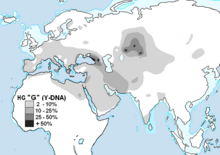Haplogroup G (Y-DNA)
| Haplogroup G | |
|---|---|
 |
|
| Possible time of origin | 9,500-30,000 years BP |
| Possible place of origin | Caucasus or Southwest Asia |
| Ancestor | Haplogroup GHIJK |
| Descendants | G1, G2 and their subclades |
| Defining mutations | L116, L154, L204, L240, L269, L402, L520, L521, L522, L523, L605, L769, L770, L836, L837, M201, P257/U6, Page94/U17, U2, U3, U7, U12, U20, U21, U23, U33 |
Haplogroup G (M201) is a human Y-chromosome haplogroup. It is one of two branches of Haplogroup GHIJK, the other being Haplogroup HIJK.
At the level of national populations, G-M210 is most commonly found in Georgia; it is found at even higher levels among many other regional and minority populations in The Caucasus. G-M210 is also widely distributed at low frequencies, among ethnic groups of Europe, South Asia, Central Asia, and North Africa.
The most commonly occurring subclades of Haplogroup G (with their corresponding SNPs in parentheses) are: G1 (M285), G2a (P15), G2a1 (L293), G2a3a (M406), G2a3b1a (L140), G2a3b1a2 (L497), G2a3b1a1a (L13/S131/U13), G2a3b1a3 (Z1903) and G2b (M377).
Various estimated dates and locations have been proposed for the origin of Haplogroup G.
In 2012, a paper by Siiri Rootsi et al. suggested that: "We estimate that the geographic origin of hg G plausibly locates somewhere nearby eastern Anatolia, Armenia or western Iran."
Previously the National Geographic Society places its origins in the Middle East 30,000 years ago and presumes that people carrying the haplogroup took part in the spread of the Neolithic.
Two scholarly papers have also suggested an origin in the Middle East, while differing on the date. Semino et al. (2000) suggested 17,000 years ago. Cinnioglu et al. (2004) suggested the mutation took place only 9,500 years ago.
The only known example of the basal paragroup G (xG1,G2) (G-M210*) is a blood sample said to have come from a man executed on a guillotine during the French Revolution. (See below for further details.)
...
Wikipedia
